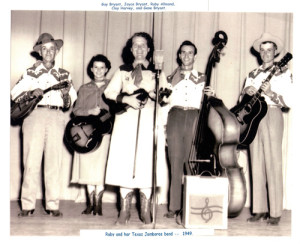Fiddlers and their trusted instruments were some of the first to cross the Appalachian Mountains with the earliest pioneers. They were special men who added pleasure to an otherwise hard, dangerous existence on the American frontier. They fiddled at house-raisings and barn-raisings, they set the pace at corn husking parties, and played all night whenever a dance was held. Fiddlers played at circuses and campaign speeches. Their music was lively with a rhythm that set toes to tapping.
The fiddle was actually a violin adapted for traditional or “folk” music styles that were played by ‘ear’ rather than by reading written music. This traditional music came to the Colonies from the British Isles and Scandinavian countries. Sometimes the fiddler played solo; at other times he played with a group of other instrumentalists, and more often than not with another fiddler known as twin fiddlers.
Notice that fiddlers were always men who believed that no woman could play a fiddle well. Ruby Allmond of Bailey in Fannin County proved them wrong and became the National Champion Woman Fiddler in a contest in 1947 held at the Greenville Municipal Auditorium. That year announcer “Pappy” Hal Horton, no relation to Greenville’s Hal C. Horton, and music promoter “Cousin” Herral Goodman of Dallas sponsored the contest to spark interest in country shows that were making the rounds of towns and small cities in North Texas. When Ruby finished, there was no doubt in anyone’s mind that she could hold her own against any male fiddler.
Ruby was born on a blackland cotton and corn farm in Fannin County in 1923. Music was the chief entertainment for the family and Ruby learned to play guitar and violin at a very early age. According to family stories, Ruby would climb on furniture to reach her brother’s fiddle and play while the men were in the fields. An outstanding student at Bailey High School, Ruby won an Interscholastic League essay-writing contest in 1939 at East Texas State Teachers’ College and a chance to compete for the statewide title. Unfortunately, Bailey High School could not finance her trip to Austin and the boys’ basketball team.
After graduating from high school, Ruby found a job at a local bank. But fiddling was still her first love. After winning the National Champion Lady Fiddler title Ruby began playing shows as a trio fiddler with two of American’s best fiddlers, Slim Rutland and Howdy Forrester. Her two brothers and Harold Carder completed the string band. Later Ruby formed her own band, Texas Jamboree. The groups played locally in Fannin County, in Hunt and Hopkins Counties, across the Red River in Oklahoma and as far away as Abilene, Texas. But Ruby always said her favorite venue was the Greenville Municipal Auditorium.
The Honorable Sam Rayburn, Speaker of the U. S. House of Representative took Ruby’s band on the campaign trail to entertain the crowds each time he was up for re-election.
In the 1950s when television began to provide popular entertainment, interest in local music shows died out. Ruby Allmond dusted off her writing skills and composed ninety original songs, including her most famous Reno. Chet Atkins produced the Dottie West version of Reno that became a top-ten national hit song. Atkins himself recorded several of her works.
This year marks the seventy-fifth anniversary of the Greenville Municipal Auditorium. Musicians and songwriters like Ruby Allmond contributed immensely in making the venue a popular stop on the local music industry of mid-20th century America.

